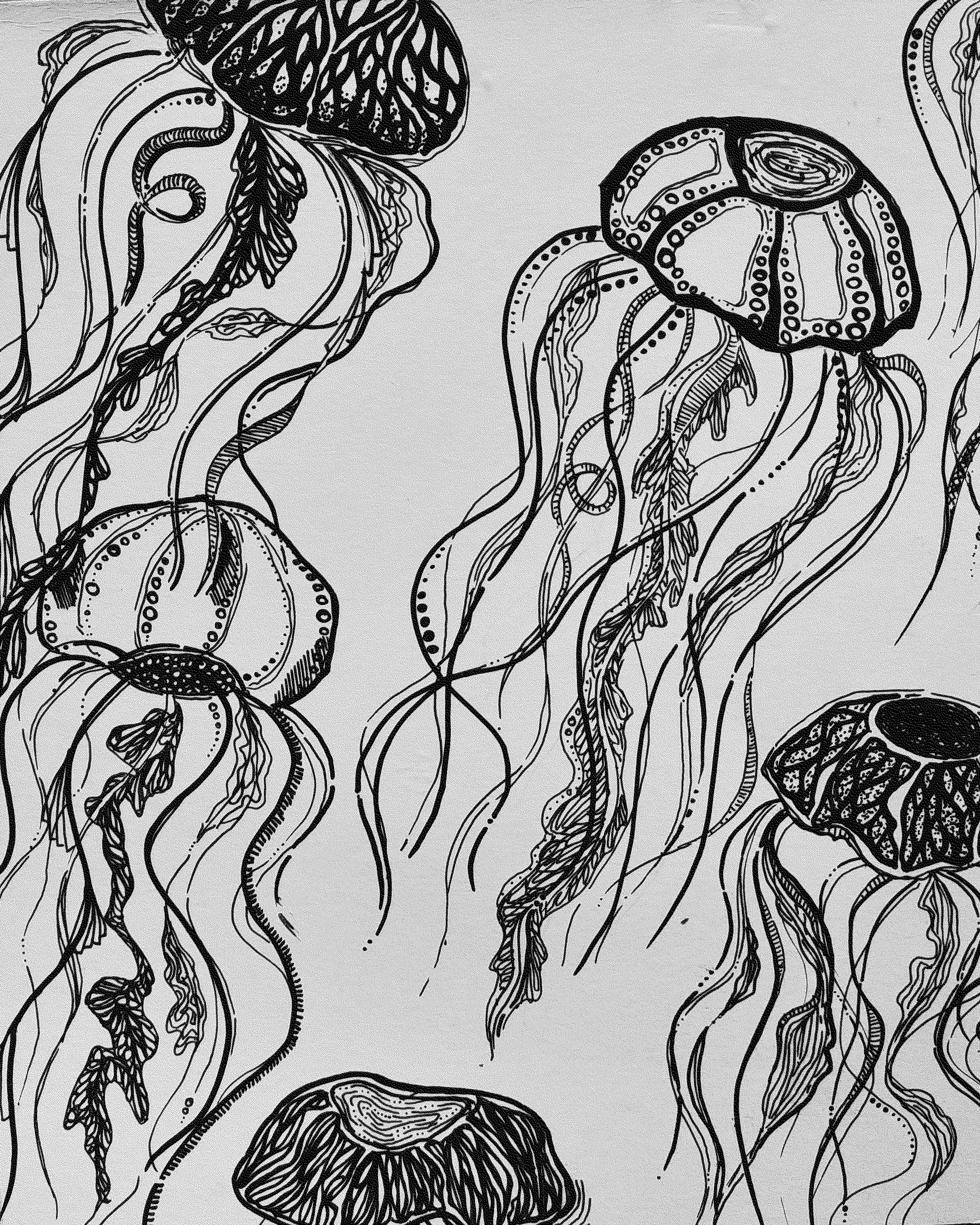Marinus

jellyfish

comb jellies

nudibranchs & marine flatworms
MY Story
Where It All Began
This series is an account of my learning about things which I didn’t know existed in such a way on our lovely planet. I spent a huge amount of time doing research and finding out what they are and the things they can do and was super inspired to make this series. It started out as a dream I had about the existence of marine creatures in the movie Finding Nemo; specifically, one scene in the beginning of the film, where Nemo’s teacher, the stingray takes his students on his back and starts naming species in the ocean. Nemo, being unbothered by the words babbled by his teacher, gazes out into the open ocean and discovers all sorts of marine beauties surrounding him.
I woke up and started scribbling jellyfish, marine flatworms and nudibranchs (essentially sea slugs), and comb jellies on pieces of card paper.
J E L L Y F I S H
Jellyfish are essentially gelatinous plankton, and not fish; made up of almost 98% water, they resemble a very jelly-like structure. What fascinates me is how delicate and light they appear, they seem to float in water so effortlessly, and look like blobby little bags of heaven. Yet, some can unleash one of the deadliest venoms on Earth or hold secrets behind some of the greatest breakthroughs in biology. It’s a wide spectrum for organisms which are mostly water. They don’t have a brain or a spinal cord, but a neural net around the bell’s inner margin forms a rudimentary nervous system that can sense the ocean’s currents and the touch of other animals.
Jellyfish also may be the most successful organisms on Earth. As other marine animals are struggling to survive in warmer and more acidic oceans, the jellyfish seem to be thriving, and perhaps getting even more numerous. There are some jellyfish whose survival strategy is extremely fascinating. When an immortal jellyfish is sick, aging, or under stress, its struggling cells can change their identity. Their tiny bell and tentacles deteriorate and turn into an immature polyp that spawns brand new clones of the parent. As far as we know, these are the only animals who found a loophole when facing mortality. That’s quite sophisticated for 95% watered blobs.
C O M B J E L L I E S
Ctenophore species are largely planktonic, exclusively marine animals, found throughout the world’s oceans, and comprise a significant portion of the planktonic biomass in their range. Comb jellies have a wide variety of body shapes, from small, roughly spherical species of less than a centimeter in diameter, to flattened, ribbon-shaped forms that reach lengths of up to two meters. Ctenophores (Greek for “comb-bearers”) have eight “comb rows” of fused cilia arranged along the sides of the animal,
Many, but not all species of ctenophores are also bioluminescent, however, producing blue-green light.
The green fluorescent protein (GFP) has generated intense interest as a marker for gene expression and localisation of gene products. Scientists isolated the gene for GFP and figured out how to insert it into the DNA of other cells. There, it acts like a biochemical beacon, marking genetic modifications, or revealing the path of critical molecules. Scientists have used the glow of GFP to watch cancer cells proliferate, track the development of Alzheimer’s, and illuminate countless other biological processes.
N U D I B R A N C H S
Nudibranchs are a new species which found its way into my circle of knowledge. The bottom-dwelling, jelly-bodied nudibranch (NEW-dih-bronk) might seem an unlikely canvas for Mother Nature to express her wildest indulgences of colour and form. But these shell-less molluscs, part of the sea slug family, bear some of the most fascinating shapes, sumptuous hues, and intricate patterns of any animal
They are carnivores that slowly ply their range grazing on algae, sponges, anemones, corals, barnacles, and even other nudibranchs. Nudibranchs derive their colouring from the food they eat, which helps in camouflage, and some even retain the foul-tasting poisons of their prey and secrete them as a defence against predators.
M A R I N E F L A T W O R M S
The Polycladida represents a highly diverse clade of free-living marine flatworms. They are known from the littoral to the sublittoral zone (extending to the deep hot vents), and many species are common from coral reefs. Only a few species are found in freshwater habitats.
Most polyclads hide away from direct light. However, some of the brightly coloured species often are active during the day. With their flamboyant colouring they advertise their potential toxicity to visual predators such as fish.
LIQUID DEATH
Flatworms are usually less than 1mm thick. Being flat has its advantages. They can get into almost every kind of space: to hide or to get at their food. Oxygen diffuses quickly across the skin and to all parts of the body, rendering them devoid of blood circulatory or respiratory systems.
set of 3 prints
size: A5
mediums: acrylic, pen
